A guide to motorhome and campervan base vehicles
Almost all campervans and motorhomes start life as a light commercial vehicle (or occasionally the car or people-carrier derivative thereof). This van, truck or chassis-cab (chassis-cowl for A-classes) is the base vehicle and it – combined with the size and weight distribution of the conversion – will define how your vehicle drives.
Some motorhome and campervan companies convert a selection of base vehicles, while others use just one basic type across their whole range. Some also offer a variety of cab spec or engine options, while for other models there may be no choice at all.
It is quite common for key features such as passenger airbags, cruise control and cab air-conditioning to be listed together in a pack, while some vehicles will also be available with engine upgrades and enhanced gross weight (read more on weights here).
VW and Mercedes-based models usually offer the widest range of automotive features, including multimedia systems and extra on-road safety systems (lane keeping, trailer assistance, sign recognition, automatic emergency braking and more).
Automatic transmissions are now much more widely available (and better) than they once were in this market, but can still be quite a costly option (and with a weight penalty, too).
However, diesel remains the dominant fuel, with any exception to this being extremely hard to find. The latest Euro 6d diesels, however, are the cleanest yet and should be futureproofed against most low emissions regulations for many years.
Electric commercial vans are available but their limited range is not really viable for leisure roles. More interesting, perhaps, is the development of hybrids, although the extra weight of batteries remains a concern.
We have split the various base vehicle models into categories of size. Car-sized are the small car-derived vans, while ‘camper’ refers to the VW Transporter and its rivals – vehicles that you’d happily drive every day. Then there is the ‘motorhome’ category that underpins a massive choice of motorhomes (from larger van conversions to coachbuilts of all types, including A-classes).
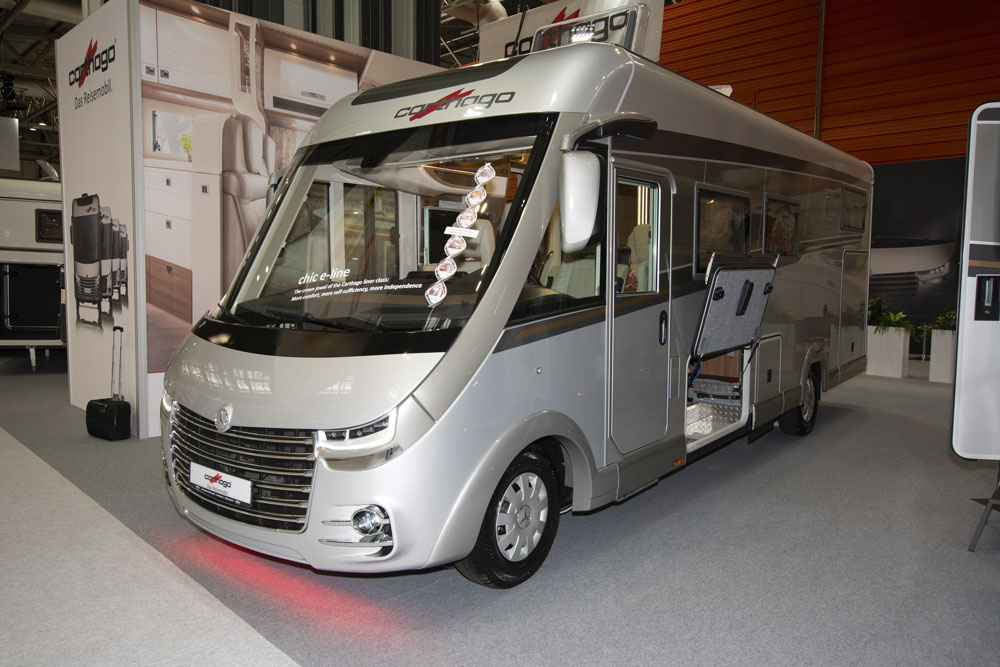
Car-sized base vehicles
Volkswagen Caddy, Ford Transit Connect
If you’re looking for a campervan that truly feels like a hatchback-sized car to drive, then there are several options. It’s not just about size here, but sitting lower in a more car-like driving position with a longer bonnet out in front. Remember, though, that a long-wheelbase Volkswagen Caddy is actually almost the same length as a short-wheelbase VW Transporter – it just looks smaller (and has a lot less living space inside).
As well as the Caddy (a new version of which is launched in 2020) – perhaps the most widely converted of this class of van (CMC Reimo, Volksleisure, etc) – other options in this category include the Fiat Fiorino/Qubo and Doblò (as converted by Wheelhome). There is also the Ford Transit Connect (basis for the Wellhouse Evie) with the rare option of a petrol engine.
In the past this sector was dominated by the Citroën Berlingo and Peugeot Partner (same van, different badges) and used versions of these are still popular for simple removable camper kits (such as Amdro and Ququq). The Berlingo has also long been the basis for the smallest coachbuilt motorhomes on the market (still offered by Nu Venture and, in the past, the bread and butter products of Romahome).
Camper-sized base vehicles
Citroën Dispatch/Peugeot Expert/Toyota Proace
Peugeot-Citroën’s latest mid-sized panel van was an all-new design in 2016 and immediately jumped to the top of the class for its car-like drive, although the interior quality is way below VW’s and space in the cab is much more confined.
Toyota also has its own version, the Proace, which is built in the same factory in France, while PSA’s acquisition of Vauxhall-Opel means that its latest (2019) Vivaro is another version of this range (but built in Luton). Previously, the Vauxhall Vivaro was a derivative of the Renault Trafic.
These vans offer car-like cab ergonomics and three lengths – 4.60m to 5.30m – on two wheelbases. There is only one roof height.
The latest Euro 6d turbo-diesel engines range from a 1.5-litre 100bhp unit with five-speed manual gearbox (replacing the previous 1.6), through 120bhp units in both 1.5 and 2-litre capacities, to a 180bhp 2-litre motor with eight-speed automatic transmission, but power unit options vary from brand to brand.
The Peugeot is available with a number of high-tech features, including plenty of active safety equipment, hands-free automatic sliding doors and a head-up display, while the Toyota comes with a five-year warranty.
Conversion-wise, there’s not a huge amount of choice but you’ll discover the likes of Campster (on Citroën) and Wellhouse (on Toyota) and Nu Venture Motorhomes offers a mini coachbuilt on the Citroën Dispatch. If you’re looking at a typical side kitchen camper layout, note that there is much less living space behind the cab of the sub-5m model than in an equivalent VW or Ford Transit Custom.
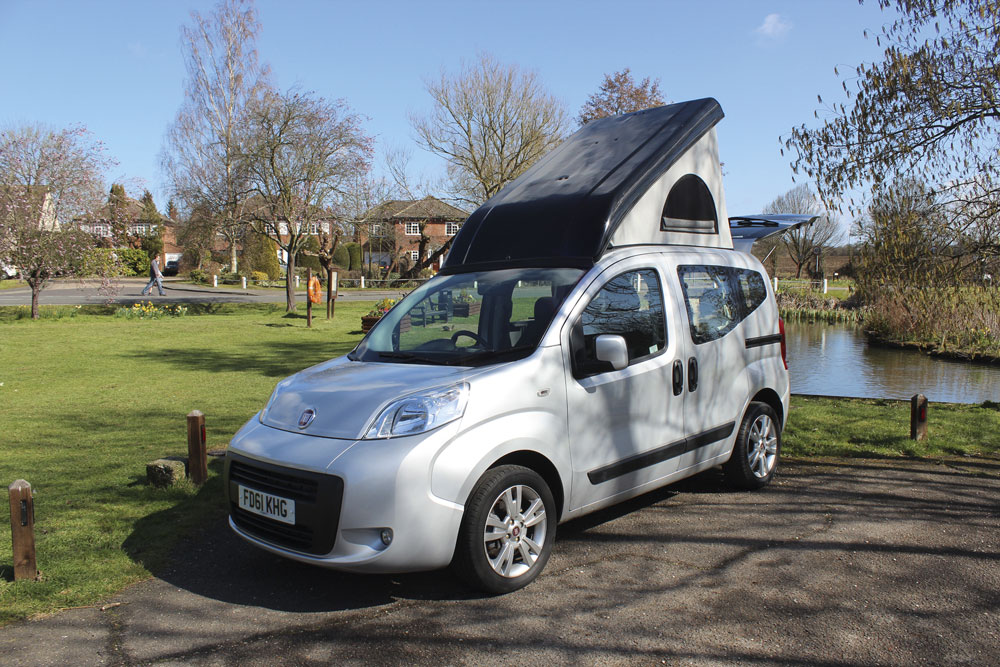
Ford Transit Custom
The Transit’s little brother is the UK’s best-selling van, so you’ll find no shortage of choice if you want a pre-owned panel van to turn into a campervan. It is offered with Ford’s EcoBlue 2-litre engine in 104bhp (105PS), 128bhp (130PS) and 168bhp (170PS) versions, plus a new 183bhp (185PS) option at the top of the range.
A six-speed torque converter automatic gearbox is an excellent alternative to the standard – and slick – manual, while all engines have been updated with new turbochargers, improved injectors and new pistons.
The Custom arrived in 2012 and quickly established itself as the VW Transporter’s most serious threat in the campervan sector. A facelift followed in 2018, which greatly improved cab ergonomics, modernised the exterior and added new safety equipment such as Intelligent Speed Assist and blindspot monitoring with Cross Traffic Alert. It is slightly roomier inside than an equivalent VW Transporter, but also slightly taller.
Unlike its big brother, Transit, the Custom comes only in front-wheel drive form, but there are two body/wheelbase lengths and two heights (the taller one, used by some converters, is not high enough to offer full 6ft standing room inside).
There is a very wide range of converters using the Transit Custom, while Ford’s Qualified Vehicle Modifier programme now includes Wellhouse Leisure. Ford has also recently launched its own Nugget campervan (built by Westfalia) in the UK and this will be available through Ford dealers, much as VW markets its own California campervan.
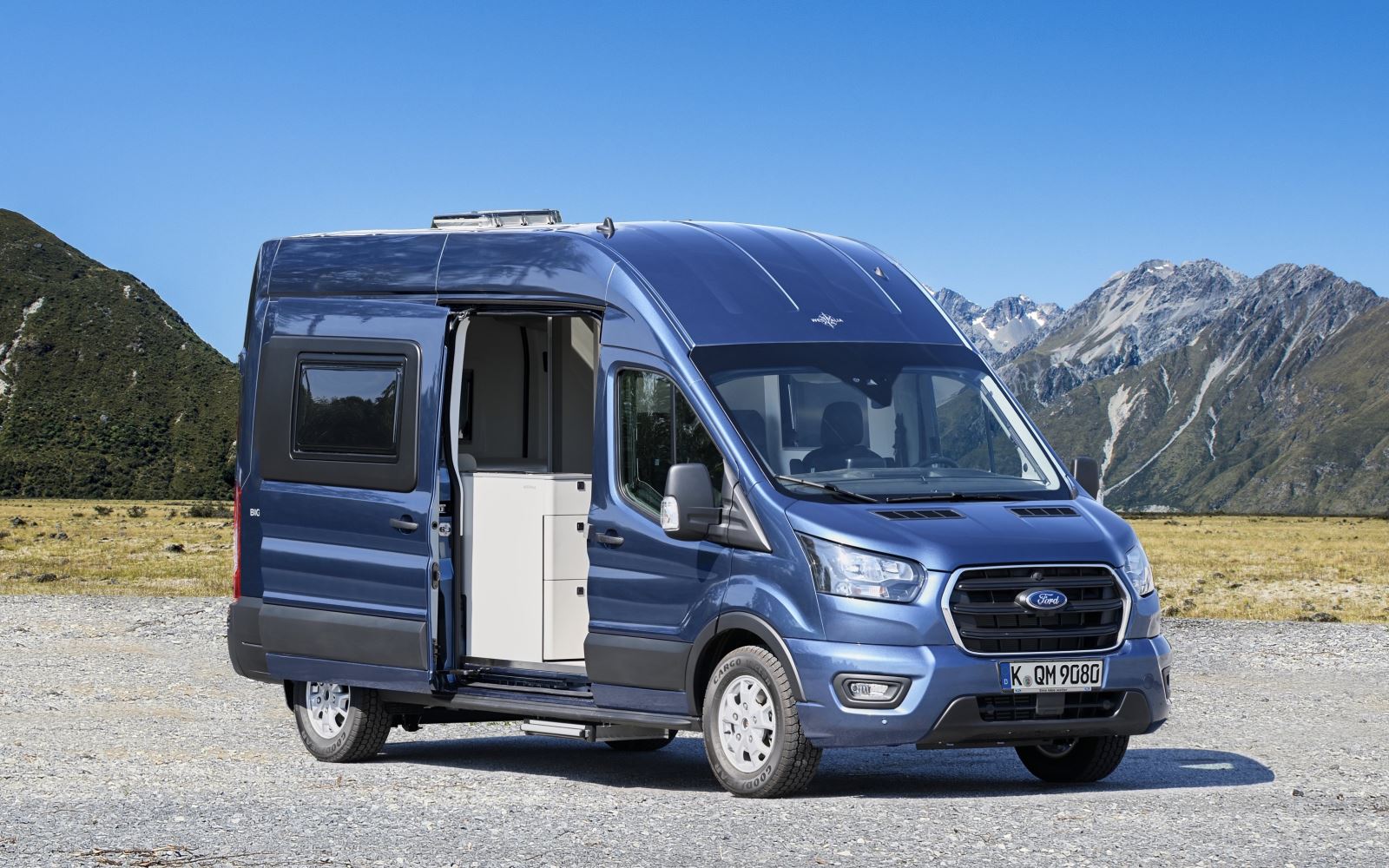
The really big news here, though, is the arrival of the very first plug-in hybrid van – the Transit Custom PHEV. This is powered uniquely by a 92.9kW (126bhp) electric motor, driving through a single-speed gearbox.
However, to avoid the limited range of pure electric vans, the Custom PHEV also has a 1-litre petrol engine which acts as a generator when the lithium ion batteries run out.
Electric-only driving range is claimed to be 35 miles, while total range using petrol as well is 310 miles – and there’s no loss of interior space as the batteries are under the floor. The only downside, then, seems to be cost, which is expected to be up to £15k more than a diesel version.
Hyundai i800/iLoad
Small numbers of the iLoad van and i800 people-carrier have been converted into campervans, primarily by Wellhouse (which uses the i800). Admired for their car-like cabin and high spec, the i800 makes an interesting and affordable, left-field alternative to a VW, especially in automatic form.
Japanese grey imports
It all started with the Mazda Bongo, before a plethora of previously unheard of people-carriers flooded into the UK to begin a new life as campervans – along with a raft of new conversion companies building on these grey imports.
Today, the Toyota Alphard and Nissan Elgrand seem to be the front runners, although you may come across others such as the Honda Elysion and Mitsubishi Delica.
All will have reached their 10th birthday before they landed on British soil (to circumvent Type Approval restrictions), so check what service history is available and look for corrosion protection (as the Japanese don’t salt their roads and vehicles sold there new are less well protected). Investigate spares backup, too.
When converted, these vehicles can offer good value, especially as cab spec tends to be to car levels and automatic gearboxes (and even four-wheel drive) are widely available. Another big plus for some buyers will be that most of these vehicles are powered by quite potent petrol engines, rather than diesel.
Mercedes Vito
The current Vito arrived in 2015, with an update following last year, but, despite the posh badge, it has never made significant inroads into the campervan market. The exception to that, of course, is Mercedes’ own camper, the Marco Polo, which is built by Westfalia and sold through Mercedes car dealerships and is based on the V-Class people-carrier with more sophisticated trim and equipment than the Vito van.
Uniquely in its class, the Vito comes in both front and rear-wheel drive forms, as well as three body lengths. Front-drive models use 1.6-litre Renault engines (88 or 114bhp), while Mercedes’ own 2.1-litre units go into rear-drive models, which are more powerful, so are the usual choice for campervans. There are 136, 163 and 190bhp units, the most powerful only offered as a seven-speed automatic.
Unusually, the parking brake is foot-operated and the auto’ gearshift stalk is on the steering column, American style, so the Vito may take a while to get used to. A plus for campers is the Vito’s low overall height, which could be important if you need to garage it.
Nissan NV200
Arguably a size smaller than the other vans here, the NV200 is tall and ‘van-shaped’ rather than looking more like a car (as with a VW Caddy). It has established itself as a more compact – and significantly cheaper – alternative to VWs, but its on-road character seems quite crude compared with the best here.
Unless you’re buying used, that’s a moot point now because Nissan UK has dropped the diesel version of this van. Only the electric E-NV200 continues. This battery-only vehicle arrived in 2014 and was updated for a greatly enhanced range (now claimed to be 174 miles) in 2018. An electric NV200 is, so far, the only battery-powered campervan we’ve driven – or seen – in the UK.
Renault Trafic/Fiat Talento/Nissan NV300
When it was launched in 2014, many viewed Renault’s Trafic as more like an MPV than a mere builder’s van. It boasted the latest in tech, a good ride and a range of frugal 1.6-litre turbo-diesel engines.
Initial enthusiasm from campervan converters (helped by pricing that’s usefully less than a VW) have never really translated into volume sales, though. However, CMC Reimo and Sussex Campervans are amongst the firms still offering the appealing French van to leisure consumers.
In 2019 a facelifted Trafic arrived with new 2-litre engines and a long-awaited six-speed automatic gearbox option. Power outputs of 120bhp, 145bhp and 170bhp are now available, with the top two offering the choice of manual or automatic.
The new models also have updated infotainment systems with Apple CarPlay and Android Auto. All the latest models have full LED headlights, while the top Business+ and Sport trim levels look particularly appealing as they have so much standard kit.
If you spot a Fiat Talento or Nissan NV300 then these are basically a Trafic in light disguise, as is a Vauxhall Vivaro prior to 2019. However, it’s the Renault version that’s most widely seen as a campervan.
Volkswagen Transporter T6.1
Two words that go together like fish and chips are Volkswagen and campervan. It’s been that way since the 1960s and now there’s a new king, the Transporter T6.1, although it’s still clearly a relative of the T5 which was the last completely new body shape for VW’s mid-sized van way back in 2003.
Nevertheless, T6.1 seems more significant than the change from T5 to T6 in 2015. The new van has a much deeper grille and narrower headlights, so it’ll be easy to spot the latest version. Then, inside there’s a brand-new dashboard with multimedia display up to 9.2in in size. Meanwhile, the change from hydraulic to electric power steering has enabled VW to install a number of new safety systems.
Two lengths are available, and two roof heights, although many converters add an after-market high-top rather than using the factory roof when customers opt for a high roof rather than the much more popular pop-top. The short-wheelbase (at 4.89m overall) is an ideal size for everyday driving, being a similar length to many large estate cars.
The T6.1 comes with a 2-litre turbo-diesel engine in 108bhp (110PS), 148bhp (150PS) and 196bhp (199PS) versions, although an all-electric derivative will follow (long-wheelbase only with a claimed 250-mile range). The previous under-powered entry-level 84PS unit has been discontinued and will be replaced by a new 90PS model.
Like the 110PS unit, this has a five-speed manual gearbox, while the more expensive engines get six ratios. The twin-clutch DSG automatic is available on the top two power units, while 4Motion all-wheel drive is offered with the 199PS twin-turbo motor. A petrol-engined T6 made a brief appearance in the UK in 2017-18 but there is no such option for the T6.1. The best all-rounder is undoubtedly the 150PS engine in either DSG or manual form, depending on personal preference.
Trim levels are Startline and Highline, with the latter adding adaptive cruise control with forward collision warning and autonomous emergency braking, App-Connect, a heated windscreen and heated, power folding mirrors.
While the VW totally dominates the campervan market – and VW’s own California (now in Ocean and Coast forms) is the best-selling campervan in the UK bar none – be aware that many VW-based campervans have had a previous life as a commercial vehicle before being converted. Some of these may have had a harder life, racked up high mileage and have begun their days with a very basic spec (look out for barn doors rather than a tailgate and no cab air-con).
There is a huge range of desirability between the top and bottom of the VW T6 campervan tree and only well-known brands will command the rock-solid residual values for which VW campers are renowned.
Motorhome base vehicles
Fiat Ducato
Fiat has been building vans with its joint venture colleagues, PSA (Peugeot-Citroën), at the Sevel factory in southern Italy since 1981.
It has long dominated the motorhome market, especially since the arrival of the X2/44-generation Ducato in 2007. This van was updated in 2014, but the latest derivative is the first to require the use of AdBlue to meet emissions regulations. Up until 2019, the Ducato was alone in its class in not using this urea-based chemical to meet the Euro 6b standard.
Apart from the AdBlue filler (in the usual place, below the diesel cap), the MY20 Ducato (as it’s known) looks virtually indistinguishable from its 2019 predecessor, which is a shame as its cab interior could do with an update in design and quality.
However, the huge range of Ducato-based motorhomes is reflected in a wide choice of specifications. The old entry-level 2-litre engine (known for its economy) has gone, so the line-up is now exclusively 2.3-litre diesel but with 120, 140, 160 and 178bhp (the last badged 180) power outputs. We’d recommend the 140 for van conversions and small coachbuilts, the 160 for larger models and overcabs.
The most significant change on the new model is, perhaps, the arrival of a nine-speed torque converter automatic gearbox (not available on the 120 engine). This super-smooth transmission replaces the clunky and frequently outwitted Comfort-Matic robotised gearshift which was a real weakpoint of the Fiat compared with the Ford Transit and Mercedes Sprinter.
Automatic versions of the 160 and 180 power units also get more torque than their manual equivalents (450Nm rather than 400Nm for the 180) which is a real plus for heavy tag-axle models.
The Fiat tops the sales charts, not just in the UK but across Europe. That success is based upon the strong relationship that Fiat has built up with the motorhome industry. Backup is class-leading, too, thanks to Fiat Camper Assistance – multi-lingual, 24-hour breakdown cover from a single phone number valid in 44 countries and 1,500 service centres across Europe.
A wide range of options is available but often the spec will be fixed by the converter rather than the end user. Look out for features like a leather steering wheel, chrome-ringed instruments, contrasting highlights on the dashboard and built-in sat-nav (the screen for which is very small) on more upmarket models.
More important is Fiat’s lowered Camper chassis, with its wider rear track, which transforms the handling of larger coachbuilts compared with those models built on a higher, standard chassis-cab. Alternatively, look for an Al-Ko rear chassis, which also offers a lower frame and wider rear axle. The longest versions have six wheels and are known as tag-axles.
Panel vans come in four different lengths – short (4.96m), medium (5.41m), long (5.99m) and extra-long (6.36m). The largest two offer plenty of interior space for a fully-equipped motorhome, while the medium-wheelbase is a useful size for those seeking a compact campervan with a loo. The short-wheelbase is very rarely seen as a motorhome.
The Fiat may not be the last word in quality or refinement, and it has a decidedly firm ride quality, but its size (internal width especially) is ideally suited to van conversions and thousands of satisfied owners tour in motorhomes based on the Ducato. For A-class buyers the only alternative is a much more expensive Mercedes Sprinter.
Ford Transit
The current (Mk 8) Transit arrived in 2014 and it’s sometimes referred to as the ‘big Transit’ to differentiate it from its smaller (suffixed) sister models, Transit Connect, Transit Courier and Transit Custom. It has been significantly facelifted in 2019 with a new front end design, softening the previously rather Americanised look.
It’s not just about cosmetics, either, as there are improved payloads resulting from a whole series of weight-saving measures, including a new manufacturing technique for the wheels, a new aluminium bonnet and a new composite bulkhead.
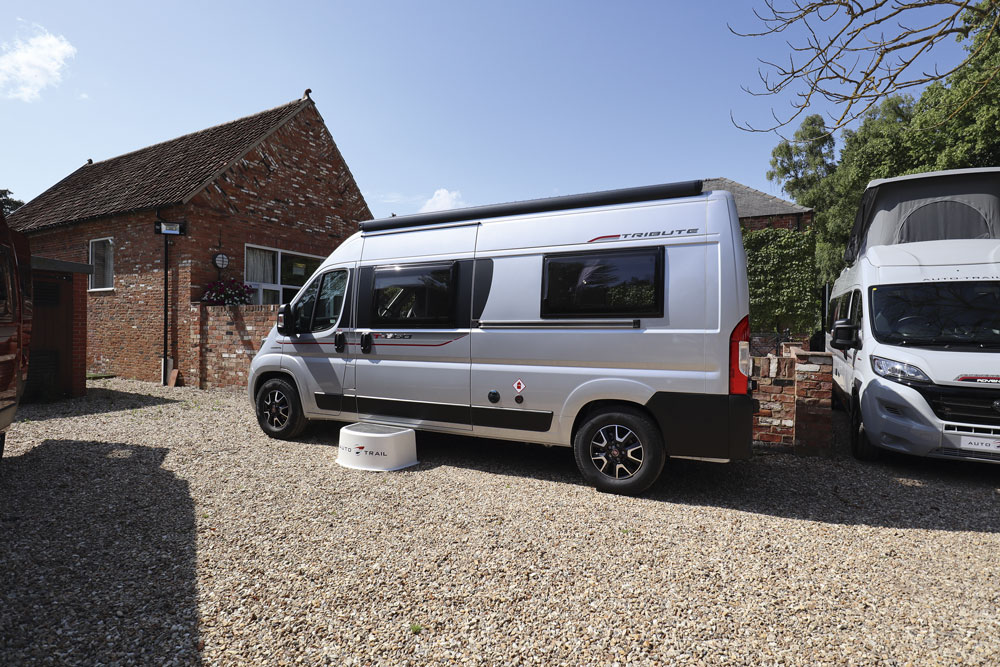
Inside, there’s a new tablet-style touchscreen on higher-spec Transits while material quality is improved, too. So, the latest Ford moves even further ahead of the Fiat Ducato in terms of its driver environment.
Previous 2.2-litre engines were replaced by 2-litre units in 2017, while 2019 models get new turbochargers, new injectors and claimed improvements to fuel economy of up to 7%. The latest Euro 6d power units come in 104bhp (105PS), 128bhp (130PS), 168bhp (170PS) and a new range-topping 183bhp (185PS) form. A six-speed automatic gearbox option has been a popular choice for Ford Transit-based motorhomes since 2016.
The Ford drives well, rides well and has a more car-like dashboard and driving position than some of its rivals. Its cab offers a reach and rake adjustable steering column, while the latest dashboard design has the ergonomics of a Focus. Shorter drivers may well find that the driving position suits them better, too.
The big Transit is available in front-wheel, rear-wheel and all-wheel drive in both panel van and chassis-cab variants but you’ll rarely see anything but front-drive in the leisure market. There is nothing like the choice of motorhomes on Ford that there is on Fiat chassis and van conversions are very few and far between.
However, if you’re looking for a coachbuilt, there’s plenty of choice from a variety of Trigano Group brands – Benimar, Chausson, Rimor and Roller Team, as well as Auto-Trail’s excellent new Tribute coachbuilts (pictured above).
Iveco Daily
The Daily’s distinctive cab is rarely seen in motorhomes as the Iveco is mostly used for large A-classes, where its 7.5-tonne maximum weight and power of up to 210bhp, along with a heavy-duty ladder chassis, explain its presence in this high-end niche. Carthago, Concorde, Dethleffs, Laika, Le Voyageur, Niesmann + Bischoff, Morelo and Swift all build on the Daily but you’ll need at least £150k to enter this sector.
Its superb Hi-Matic, torque converter, eight-speed automatic gearbox is the icing on the cake, while the 2019 Daily has had a facelift and comes with new tech/safety features.
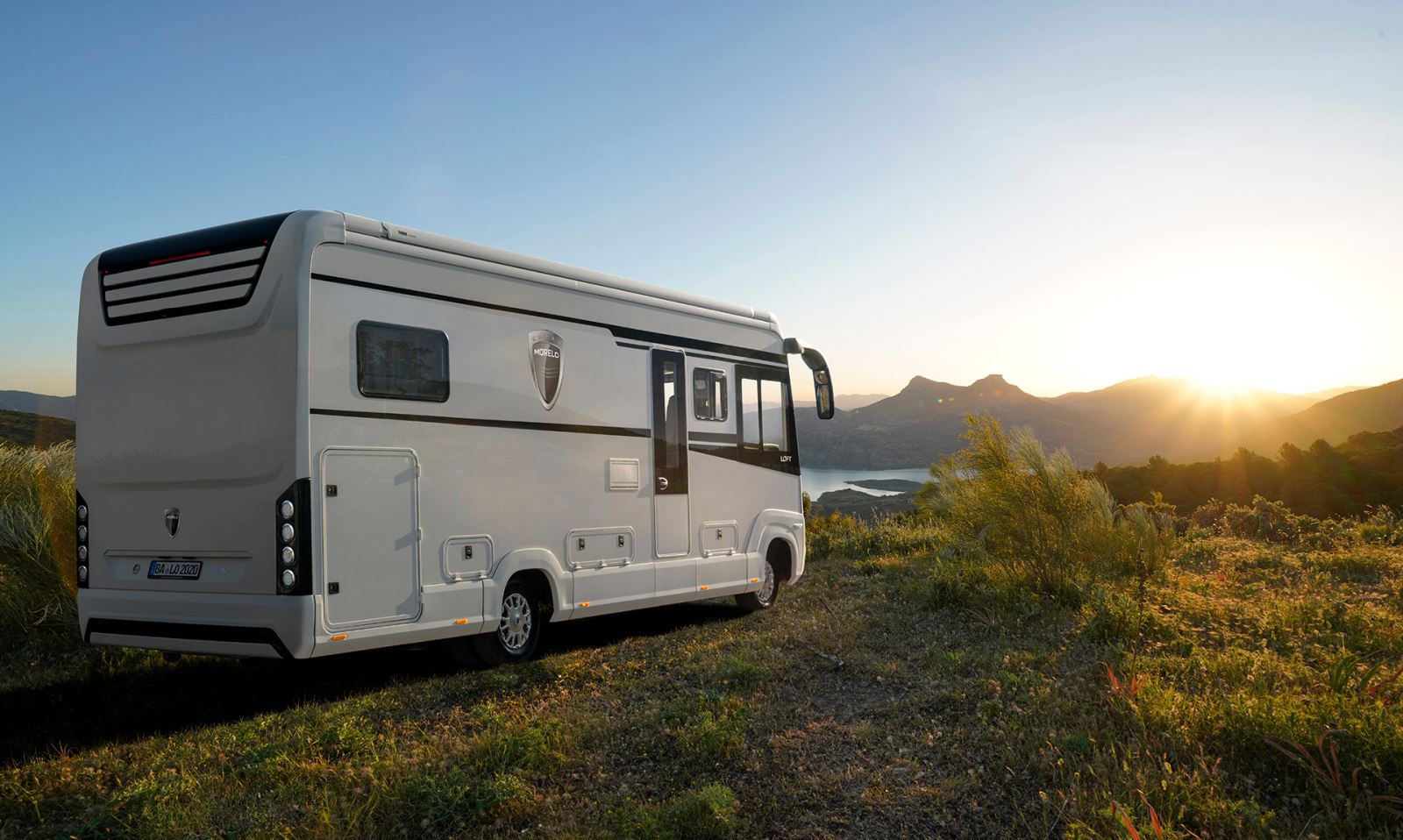
Mercedes Sprinter
The Sprinter can be an expensive choice, but for some it’s worth the extra. There’s the kudos of the three-pointed star, of course, but the latest Merc also has class-leading sophistication, including the option of a 10.25in MBUX dashboard display with sat-nav and even voice-operated commands.
For the first time the Sprinter comes with front-wheel drive as well as the traditional rear-wheel drive, the former benefitting from 50kg extra payload and a nine-speed automatic gearbox option (RWD models get seven speeds, though both are excellent torque converter transmissions). Adventurers will also be drawn to the Sprinter for its 4x4 option which features massive extra ground clearance.
The RWD Merc does not feel quite as precise at the helm as a Fiat or Peugeot but the ride is superior to the Sevel duo, while the new front-wheel drive version is as good to drive as anything in the class. While also having some of the smoothest four-cylinder diesel engines around, the range-topping 190bhp 3-litre V6 (in RWD and 4x4 versions) is especially impressive.
The 2.1-litre diesel engines in FWD models come in 112bhp, 140bhp, and 177bhp versions (the last exclusive to the motorhome market), while RWD models get 112bhp, 143bhp or 163bhp.
A whole raft of safety kit is available, including Crosswind Assist, Blindspot Assist, Collision Prevention Assist, High Beam Assist and adaptive ESP. Keyless starting is available, while the electric parking brake option means there’s no lever to obstruct cab seat swivels.
Auto-Sleepers, Frankia and Hymer each have a long and consistent history of building Mercedes-based motorhomes, while the much-improved 2019 Sprinter has seen other major names, such as Bürstner, Carthago, Dethleffs and Rapido, join the fray.
In both van conversions and, especially, coachbuilts, the Mercedes is a much more desirable option than Fiat for more upmarket motorhomes and we’re expecting the number of Sprinter-based options to continue to grow.
Peugeot Boxer/Citroën Relay
The Boxer and Relay look a lot like the Fiat Ducato because they’re basically the same van, built in Italy. All three are regularly referred to as ‘Sevel’ vans after the factory in which they’re made. However, the Peugeot/Citroën versions come with different engines to their Fiat cousins and neither of the French brands offers an automatic version.
New for 2019 are 2.2-litre Euro 6d engines, replacing the previous 2-litre Euro 6b units (which require AdBlue, unlike Fiats of this era). The new models have stop/start as standard and come with 120bhp, 140bhp and 165bhp outputs. The top version (widely seen in motorhomes) is up 5bhp (and, more importantly, 20Nm of torque) over its predecessor.
Several major UK motorhome manufacturers use the Peugeot Boxer (including Auto-Sleepers, Bailey and Elddis), but the lion badge is almost never seen on Continental motorhomes. Conversely, Citroën is the more widely used chassis across the Channel and a few imported models (including Adria, Bürstner and Hobby) have come here, although these are badged Jumper rather than Relay (which is a UK-only moniker).
Renault Master
Renault’s big van has just received a facelift but is now almost completely absent from the motorhome market. We previously liked the smooth ride of the Master but were less enamoured of its rather bus-like driving position. We understand that WildAx will continue to convert the panel van but there is no news yet of any coachbuilts based on the latest Renault Master.
Volkswagen Crafter/MAN TGE
The latest Crafter debuted in 2017 and has become the driver’s choice in the motorhome market. In many ways it feels like a bigger T6, while its cab design and quality are everything you’d expect from VW.
The pre-2017 Crafter was built in partnership with Mercedes, leading to it looking a lot like the Sprinter, but this current van is built at a brand-new Volkswagen factory in Poland and is in no way related to the Mercedes. It does, however, have a badge-engineered clone, the TGE from truck manufacturer, MAN (its first ever panel van).
Drivetrains include front-wheel drive, rear-wheel drive and 4Motion all-wheel drive. The 2-litre engines diesel engines offer 102bhp, 122bhp, 140bhp, and (with twin turbos) 177bhp. Manual, six-speed and eight-speed torque converter-based automatic gearboxes are available. The 177bhp auto’ is an especially appealing combination.
There are three overall lengths on offer (5.98m, 6.83m, 7.39m), giving plenty of scope for converters to create different layouts. And, as with many of the latest vans, the Crafter can bristle with tech, a lot of it aimed at safety: adaptive cruise control, lane keeping assist, rear traffic alert – even parking assist, which does the steering for you as the van slots into a space.
However, while a number of van conversions (Hillside, IH, Knaus, Westfalia) have been seen on the Crafter, only Knaus has used this chassis (in MAN form) for coachbuilts. Other manufacturers are also believed to be developing MAN-based models.
In the meantime, VW’s own in-house Crafter-based motorhome, the Grand California, takes a motor manufacturer into this sector for the first time. It’s sure to appeal to T6 California owners wanting to trade up to a larger campervan with onboard shower/toilet facilities and, like its little brother, it is being retailed through VW Van Centres.
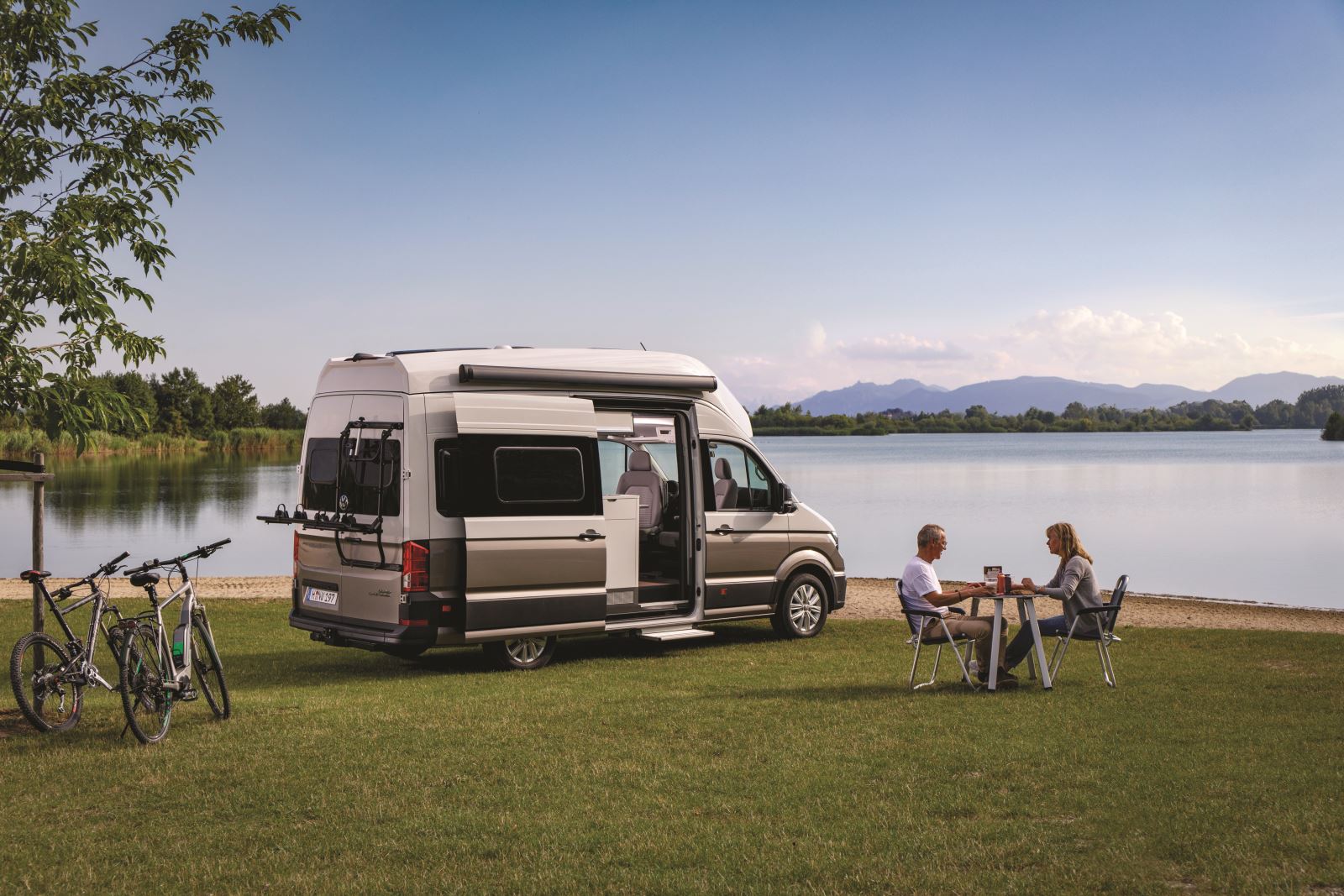
This article was originally published in Buying Your First Motorhome 2020, which was created by the team behind MMM, What Motorhome and Campervan magazines. It will guide through you every aspect of buying a motorhome or campervan, whether you're a first-time buyer or looking to upgrade an existing model. You can buy a digital edition of Buying Your First Motorhome 2020 for just £4.99 here.
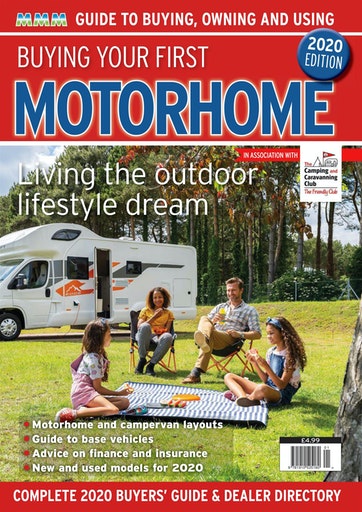








Recent Updates
Engine management lights: all you need to know
What is the engine management light? What does it mean, and what do I have to do? ...
Motorhome air suspension: all you need to know
Motorhomes are heavy and the additional weight of equipment and height of the bodywork can increase the loads ...
Motorhome WiFi: how to get better motorhome internet
Staying connected on the move is more and more essential, so relying on campsite WiFi isn't an option – here ...
A class of their own - our guide to A-class motorhomes
Thinking of trading up to an A-class, or even going straight to the top of the motorhome tree? We guide you ...
Explore overseas on a motorhome dream tour
Enjoy exotic travel in a campervan or motorhome by hiring, swapping with someone else or exporting your ...
Motorhome water systems: everything you need to know
On-board water is an important part of every motorhome – here’s everything you need to know ...
Campervanning in Europe: what you need to know
Whether you're planning a leisurely drive through the French countryside, navigating bustling city streets in ...
Campervan security: all you need to know
With thefts on the increase, it’s important to know how to keep your campervan secure and prevent campervan ...
Campervan furniture: everything you need to know
Our campervan experts guide you through all the essentials for your campervan, including tables, chairs, ...
Campervan finance: how to fund your purchase
Here we look at the different types of campervan finance available, to help you decide what’s the best option ...
Other Articles
Britain’s best used motorhomes
Want a great motorhome without paying the premium for a new one? Here's a guide to the best you can get in the pre-owned market for each layout, ...
Which motorhome? Choosing the perfect motorhome for you
Choosing a motorhome or campervan is one of the biggest buying decisions you’ll ever make, so it's important ...
Campervan washroom essentials: stay fresh on the road
Our guide will take you through the campervan washroom essentials you'll need so you're well-prepared for ...
Dogs in campervans: all you need to know
Follow our advice and your dog will enjoy campervanning as much as you do ...
Electric campervans: all you need to know
Our guide will take you through everything you need to know about electric campervans and what the future ...
Motorhome electrics: a complete guide to your motorhome electrical set-up
Motorhome electrics can dramatically enhance the convenience and comfort of your vehicle – but they can be ...
Lighting for campervans: all you need to know
We guide you through all the lighting options available for you and your campervan, including interior ...
Electric bikes for motorhomes: our ultimate guide
Read our comprehensive guide to electric bikes for motorhome owners, helping you add electric power to your ...
Our guide to 'cheap' motorhomes in 2024
If you're on the hunt for an affordable new motorhome, this is the best place to start – we've rounded up a ...
Campervans in winter: all you need to know
Here's your guide to preparing your campervan for the colder months, whether you will be using it or putting ...